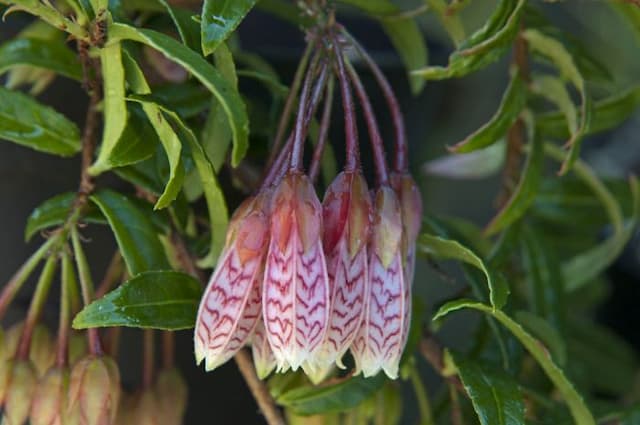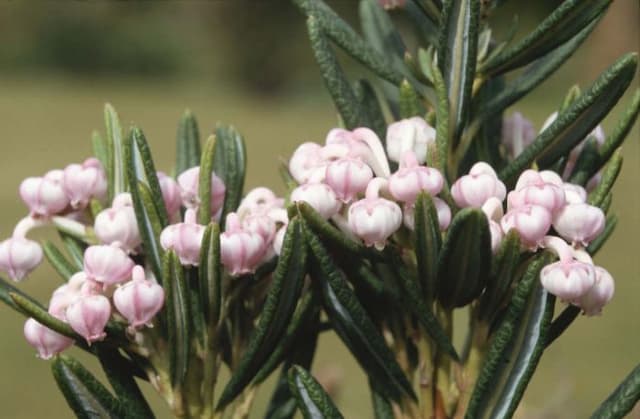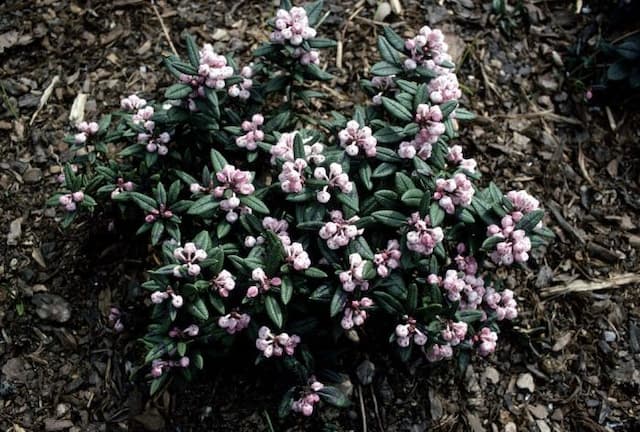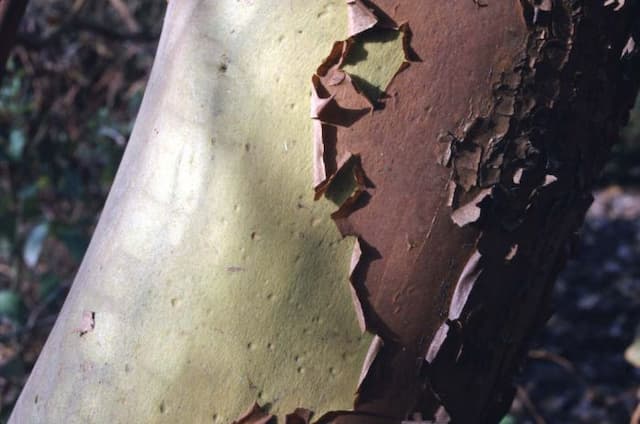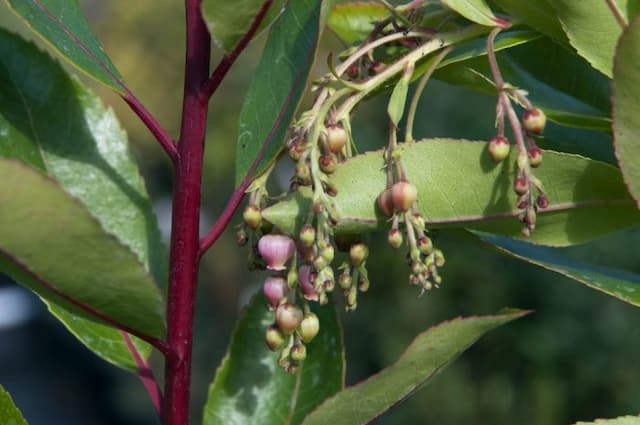Cape Heath Erica versicolor

ABOUT
Erica versicolor, commonly known as the Cape Heath, is an evergreen shrub that boasts a showy display of tubular flowers, which come in a palette of colors including pink, coral, and red. These blossoms are arranged in clusters along the stems, providing a dense and colorful inflorescence that is highly attractive to both the human eye and various pollinators. The narrow, needle-like leaves are typically small and arranged in whorls around the stem, giving the plant a fine-textured appearance. The foliage often has a leathery feel and can range in color from bright green to dark green, sometimes with hints of gray, creating a nice contrast to the vibrantly colored flowers. The overall appearance of Cape Heath is one of delicate beauty, with its slender stems giving the impression of a plant that is both graceful and robust.
About this plant
 Names
NamesFamily
Ericaceae
Synonyms
Cape Heath, Versicolor Heath
Common names
Erica versicolor.
 Toxicity
ToxicityTo humans
Erica versicolor, commonly known as Cape Heath, is not widely known for its toxicity to humans. There is limited information suggesting that this plant poses significant risks if ingested. However, as with any plant, individual allergies or sensitivities could potentially cause mild to moderate symptoms like upset stomach, vomiting, or diarrhea if ingested. It's always prudent to avoid consuming parts of ornamental plants due to potential unknown toxicities.
To pets
Cape Heath (Erica versicolor) is not typically listed as a toxic plant to pets such as dogs and cats. However, the absence of toxicity reports doesn't guarantee that a plant is completely safe. Some pets may have individual sensitivities or allergic reactions to non-toxic plants, which could cause mild gastrointestinal upset if ingested. Owners should still prevent pets from eating plants, as a general precaution.
 Characteristics
CharacteristicsLife cycle
Perennials
Foliage type
Evergreen
Color of leaves
Green
Flower color
Varies
Height
3 feet (0.9 meters)
Spread
3 feet (0.9 meters)
Plant type
Shrub
Hardiness zones
7
Native area
South Africa
Benefits
 General Benefits
General Benefits- Attractive Ornamental: Erica versicolor, commonly known as the Cape Heath, adds visual appeal to gardens with its vibrant flowers and evergreen foliage.
- Habitat for Wildlife: It provides nectar for bees and other pollinating insects, contributing to the local ecosystem.
- Drought Tolerance: Cape Heath is known for its ability to withstand periods of dryness once established, making it suitable for water-efficient landscaping.
- Versatile Gardening: This plant can be used in various garden designs, including rockeries, borders, and as groundcover.
- Long Blooming Period: The Cape Heath offers a lengthy season of blooms, bringing color to the garden when many other plants may not be flowering.
- Erosion Control: Its root system helps stabilize soil on slopes, reducing soil erosion.
- Minimal Maintenance: Erica versicolor typically requires low maintenance, making it a practical choice for gardeners of all levels of experience.
- Seasonal Interest: With year-round foliage and flowers that bloom at different times, it provides continual interest throughout the seasons.
 Medical Properties
Medical Properties- This plant is not used for medical purposes.
 Air-purifying Qualities
Air-purifying QualitiesThis plant is not specifically known for air purifying qualities.
 Other Uses
Other Uses- Ornamental Gardening: Erica versicolor, commonly known as Cape Heath, is used extensively for ornamental purposes in gardens and landscapes for its attractive flowers and evergreen foliage.
- Floral Arrangements: The vibrant flowers of Cape Heath can be used in floral arrangements and bouquets, providing a splash of color and an exotic touch.
- Erosion Control: Cape Heath can be planted on slopes and banks to help stabilize soil and prevent erosion due to its dense root system.
- Ground Cover: Gardeners often use Cape Heath as a ground cover plant to suppress weeds and cover bare spots in gardens due to its low-growing nature.
- Wildlife Attraction: The flowers of Cape Heath are known to attract various pollinators, including bees and butterflies, which can help to maintain a healthy ecosystem in the garden.
- Bonsai: Some enthusiasts use Cape Heath for creating bonsai due to its small leaves and the potential for interesting shapes through pruning.
- Cultural Significance: In certain cultures, Cape Heath may be used in traditional ceremonies or garden designs that hold cultural importance.
- Photography: The striking bloom of Cape Heath is a subject of interest for nature photographers, especially when capturing the essence of heathland or fynbos ecosystems.
- Privacy Screens: Taller varieties of Cape Heath can be planted in rows to create a natural, flowering screen for privacy in gardens.
- Artistic Inspiration: Artists may be drawn to Cape Heath as a subject for paintings, drawings, or other forms of artistic expression due to its vibrant colors and delicate structure.
Interesting Facts
 Feng Shui
Feng ShuiThe Cape Heath is not used in Feng Shui practice.
 Zodiac Sign Compitability
Zodiac Sign CompitabilityThe Cape Heath is not used in astrology practice.
 Plant Symbolism
Plant Symbolism- Endurance – Erica versicolor can withstand tough conditions, demonstrating the ability to endure challenges and survive in adverse circumstances.
- Adaptability – This plant's versatility in growing in various soil types and environments represents flexibility and the willingness to adapt.
- Solitude – Often found in less dense areas, Erica versicolor can symbolize a preference for solitude or the enjoyment of one's own company.
- Purity – The delicate blossoms of the Cape heath may be associated with purity and innocence due to their gentle and unassuming appearance.
- Protection – Traditionally, heaths are thought to have protective qualities, offering a safe haven for wildlife and thus symbolizing protection and refuge.
 Water
WaterThe common name for Erica versicolor is Cape Heath. This plant prefers consistent moisture, so it should be watered regularly but not excessively. The frequency of watering can range from twice a week to every other day, depending on the climate and season. Always check the top inch of the soil; if it feels dry, it's time to water. When watering Cape Heath, use approximately one gallon of water to ensure the moisture reaches deep into the root system, adjusting the amount during rainy seasons or in naturally moist environments.
 Light
LightCape Heath thrives in bright, indirect light or dappled sunlight. The ideal spot for this plant is somewhere with morning sun and afternoon shade, as too much direct sunlight can scorch the foliage. It can also tolerate full sun in cooler climates but must be protected from the harsh midday sun in warmer regions.
 Temperature
TemperatureCape Heath prefers a cool to moderate temperature range, thriving between 50 to 75 degrees Fahrenheit. While it can withstand temperatures down to 30 degrees Fahrenheit for short periods, frost can harm the plant. The ideal climate for Cape Heath is similar to its native South African environment, with mild temperatures and not too much extreme heat or cold.
 Pruning
PruningPrune Cape Heath primarily to shape the plant or maintain its size and to remove any dead or diseased branches. The best time for pruning is immediately after flowering, which helps stimulate new growth and ensures a healthy flush of flowers the following season. Pruning can be done annually or as needed, depending on the growth rate and desired size of the plant.
 Cleaning
CleaningAs needed
 Soil
SoilThe Cape Heath, or Erica versicolor, thrives best in an acidic, well-draining soil mix with a pH of 4.5 to 5.5. A mixture of peat, sand, and loam works well, ensuring adequate drainage while retaining some moisture.
 Repotting
RepottingCape Heath plants should be repotted every 2 to 3 years to refresh the soil, as they tend to grow relatively slowly. They should only be repotted when the roots have filled the pot, usually in spring before new growth begins.
 Humidity & Misting
Humidity & MistingCape Heath prefers moderate to high humidity levels, ideally between 60% to 80%. It’s important to provide these conditions, especially when growing the plant indoors, to mimic its natural environment.
 Suitable locations
Suitable locationsIndoor
Grow Cape Heath in acidic soil, bright light, and ensure high humidity.
Outdoor
Plant Cape Heath in acidic soil with good drainage in a sunny spot.
Hardiness zone
7-9 USDA
 Life cycle
Life cycleErica versicolor, commonly known as the 'Cape Heath,' begins its life cycle as a seed, which germinates in well-drained, acidic soil, typically requiring exposure to fire or smoke to trigger sprouting. Upon germination, a seedling emerges and develops into a juvenile plant, during which it establishes a root system and begins to form its characteristic needle-like leaves. The plant enters a vegetative state of growth, where it matures and increases in size, often forming a dense, bushy shrub. After reaching maturity, which can vary in time depending on environmental conditions, the Cape Heath produces bell-shaped flowers, varying from pink to purple, which are pollinated by insects, most commonly bees. Upon successful pollination, the flowers develop into small seed capsules that eventually dry and release seeds to complete the reproductive cycle. Over time, older plants may decline and die, but they contribute to the seed bank, ensuring the continuation of the species in the ecosystem.
 Propogation
PropogationPropogation time
Spring to summer
For Erica versicolor, commonly known as the Cape Heath, the most popular method of propagation is by semi-hardwood cuttings. This typically takes place in late summer to early fall, when the plant's growth begins to slow down and the stems have partially matured. To propagate by cuttings, select healthy, disease-free stems and cut a 3 to 5-inch (8 to 13 cm) length, making sure each cutting has several leaves. Dip the cut end in rooting hormone powder to promote root development, then insert the cutting into a well-draining potting mix. The potting medium should be kept moist until the cuttings have rooted, which usually takes several weeks. To maintain a high humidity level, cover the cuttings with a plastic bag or place them in a propagation case. Once rooted, the cuttings can be transplanted to individual pots and grown on before being planted out.
